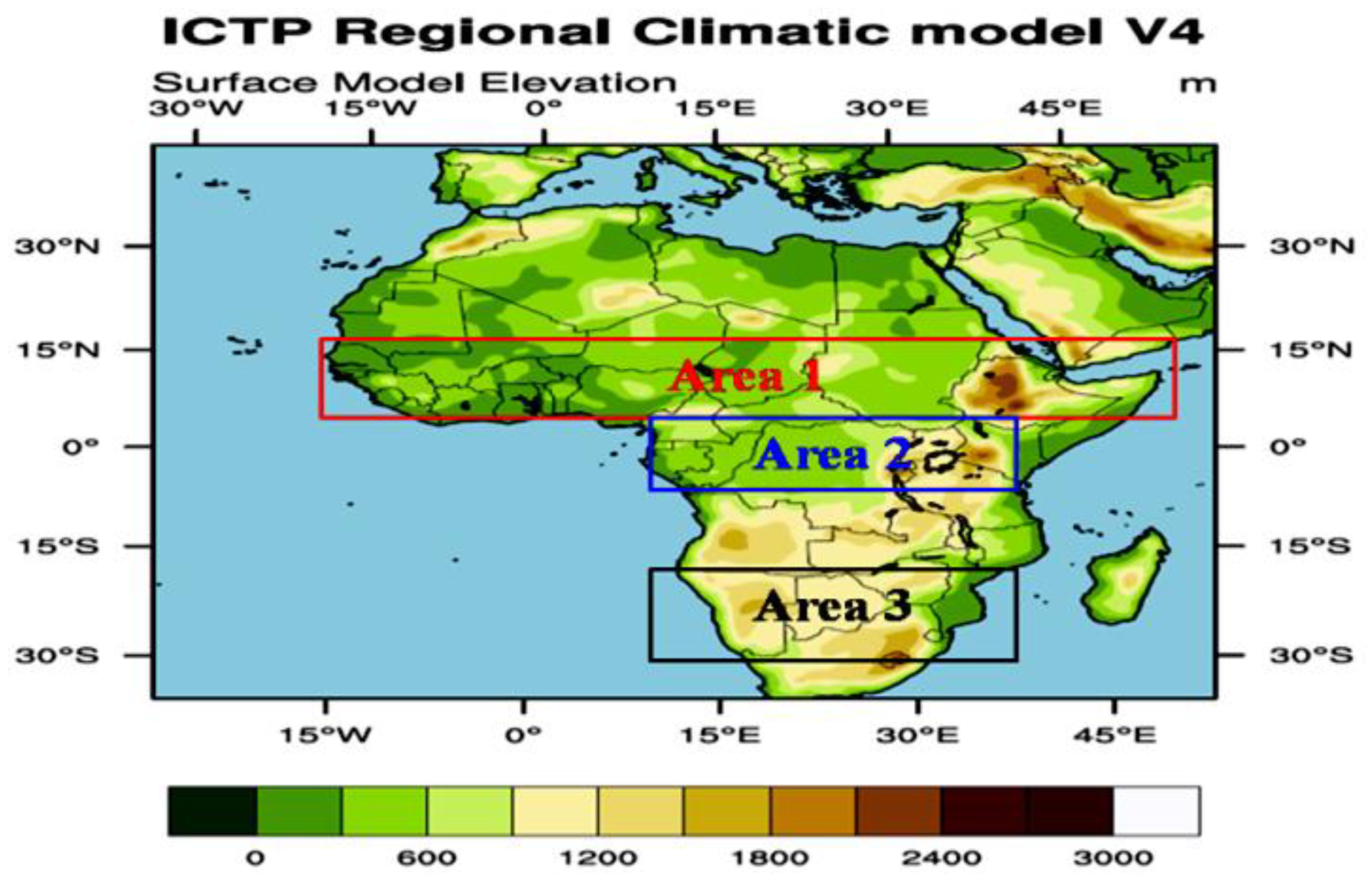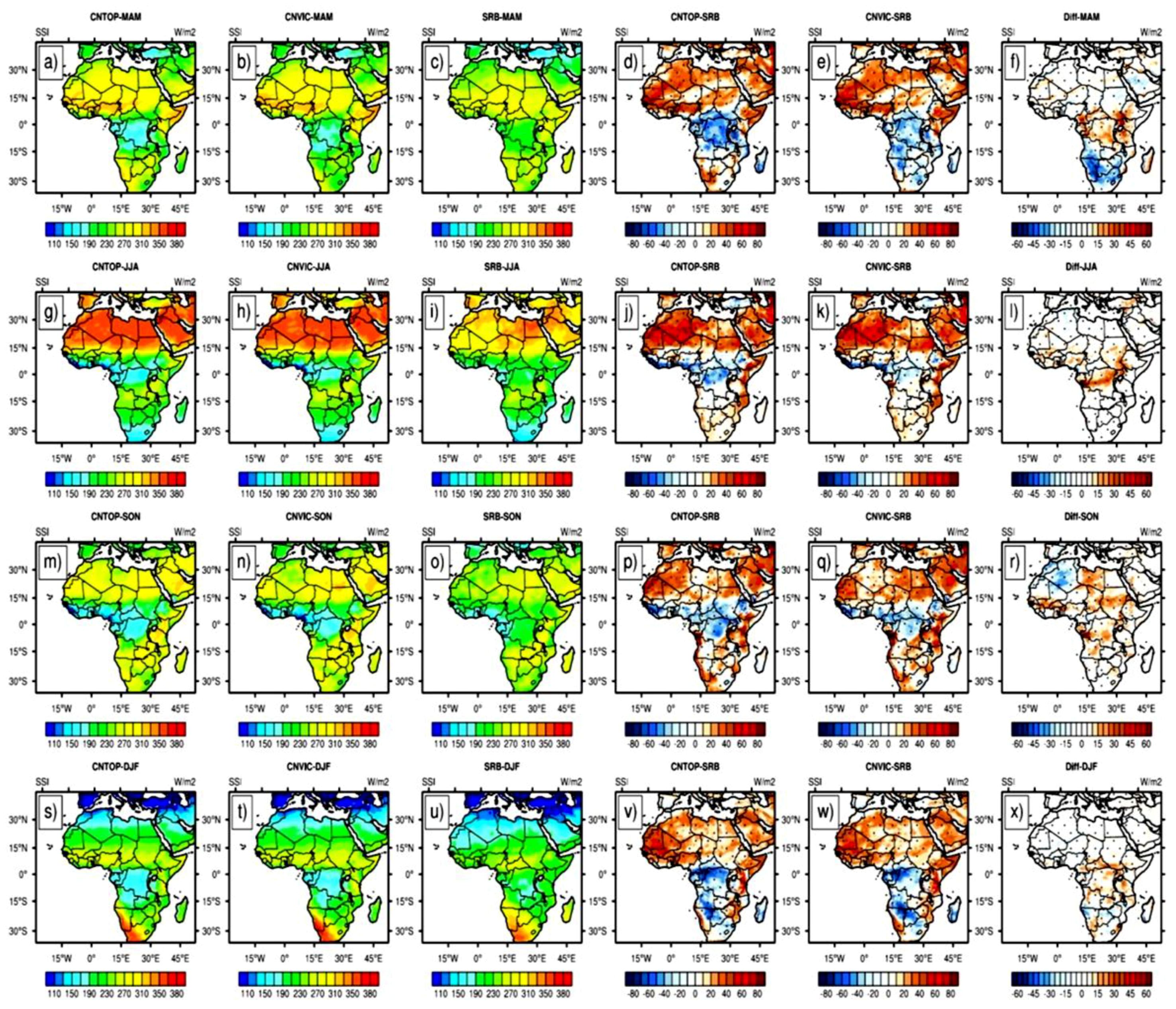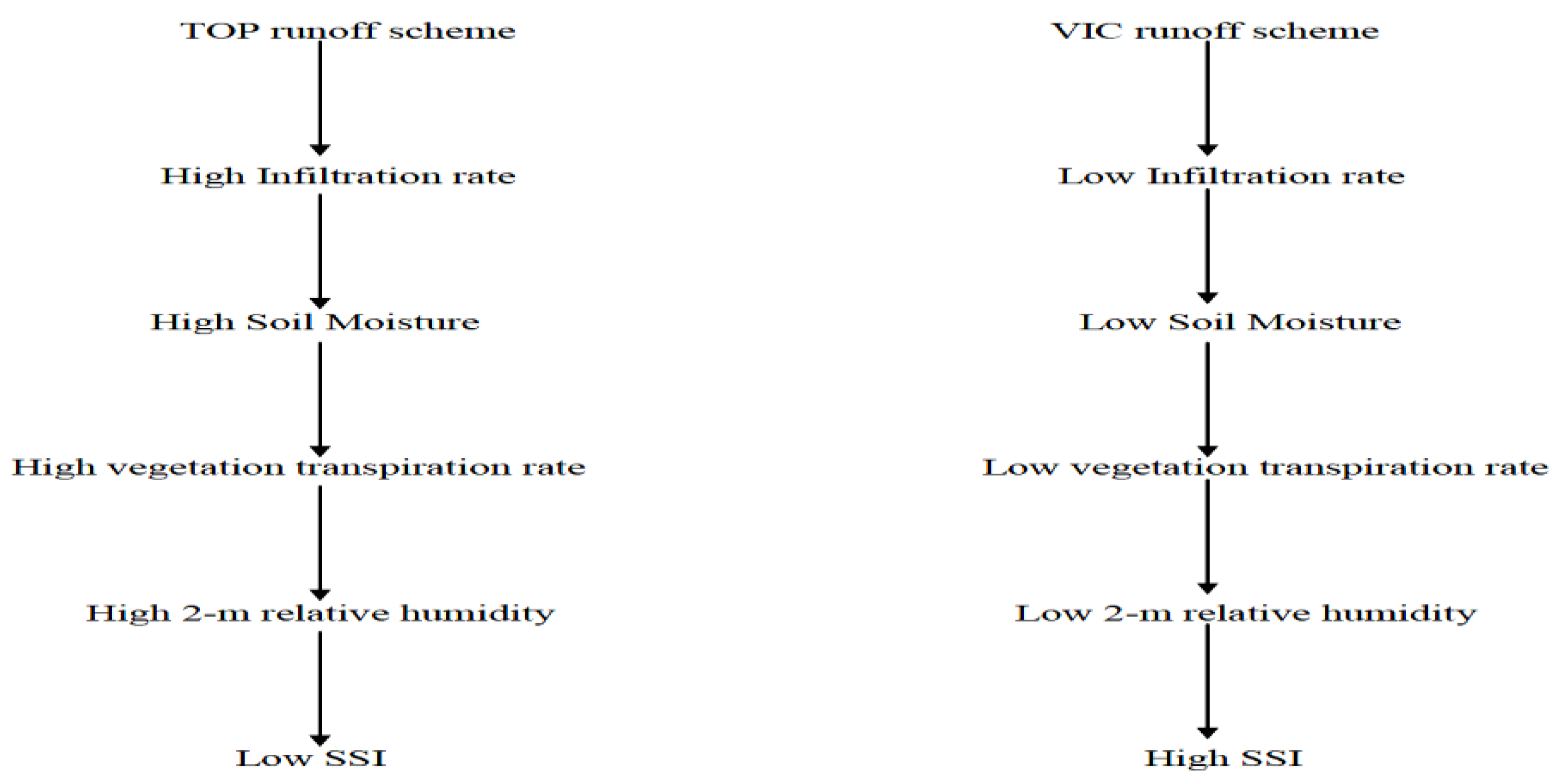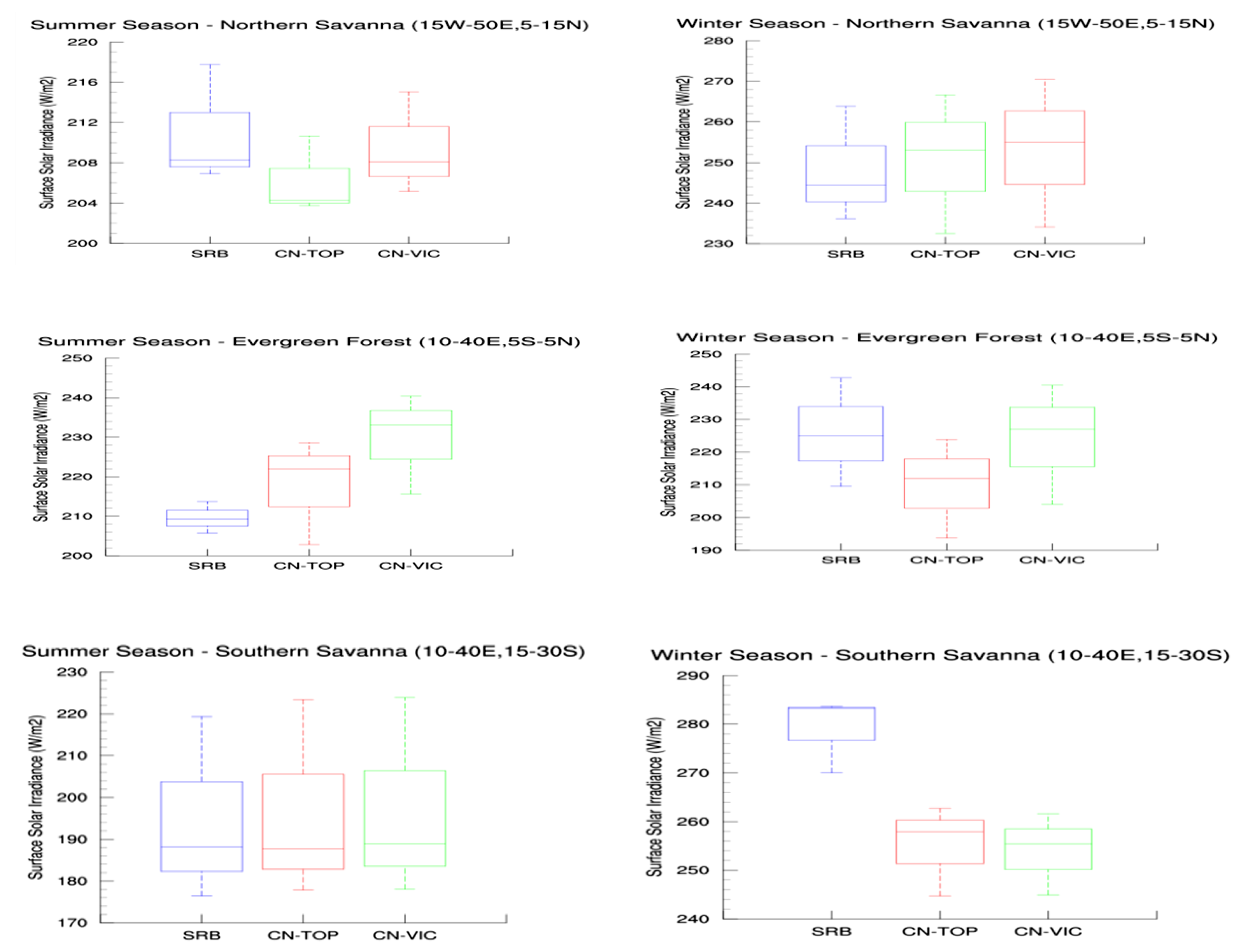Simulating the Surface Solar Irradiance of Africa Using a Regional Climate Model: Influence of Vegetation-Runoff Coupled System †
Abstract
1. Introduction
2. Materials and Methods
3. Results
3.1. Seasonal Climatology of SSI
3.2. Correlating the SSI with Hydrological Variables
4. Summary and Conclusions
- The role of aerosols and various clouds cover schemes which notably affect the simulated SSI.
- Downscaling CMIP5 General Circulation Models (GCMs) participating in the CMIP5/CMIP6 simulations (e.g., [19,20]) using the regional coupled RegCM4-CLM45-CN-VIC model with enabling the dynamic vegetation (DV) module and LULCC to assess the possible future changes in the simulated SSI under the moderate scenario (RCP4.5) and extreme scenario (RCP8.5).
- Examine the potential influence of the vegetation-runoff systems on the vertical radiation profile.
Funding
Institutional Review Board Statement
Informed Consent Statement
Data Availability Statement
Acknowledgments
Conflicts of Interest
References
- Sawadogo, W.; Reboita, M.S.; Faye, A.; Da Rocha, R.P.; Odoulami, R.C.; Olusegun, C.F.; Adeniyi, M.O.; Abiodun, B.J.; Sylla, M.B.; Diallo, I.; et al. Current and future potential of solar and wind energy over Africa using the RegCM4 CORDEX-CORE ensemble. Clim. Dyn. 2021, 57, 1647–1672. [Google Scholar] [CrossRef]
- Giorgi, F.; Jones, C.; Asrar, G.R. Addressing climate information needs at the regional level: The CORDEX framework. World Meteorol. Organ. (WMO) Bull. 2009, 58, 175. [Google Scholar]
- Anwar, S.A.; Zakey, A.S.; Robaa, S.M.; Wahab, M.M. The influence of two land-surface hydrology schemes on the regional climate of Africa using the RegCM4 model. Theor. Appl. Climatol. 2019, 136, 1535. [Google Scholar] [CrossRef]
- Giorgi, F.; Coppola, E.; Solmon, F.; Mariotti, L.; Sylla, M.B.; Bi, X.; Elguindi, N.; Diro, G.T.; Nair, V.; Giuliani, G.; et al. RegCM4: Model description and preliminary tests over multiple CORDEX domains. Clim. Res. 2012, 52, 7–29. [Google Scholar] [CrossRef]
- Oleson, K.W.; Lawrence, D.M.; Bonan, G.B.; Drewniak, B.; Huang, M.; Koven, C.D.; Levis, S.; Li, F.; Riley, W.J.; Subin, Z.M.; et al. Technical Description of Version 4.5 of the Community Land Model (CLM); NCAR technicalnote NCAR/TN-503 + STR; National Center for Atmospheric Research: Boulder, CO, USA, 2013. [Google Scholar]
- Anwar, S.A.; Diallo, I. On the role of a coupled vegetation-runoff system in simulating the tropical African climate: A regional climate model sensitivity study. Theor. Appl. Climatol. 2021, 145, 313–325. [Google Scholar] [CrossRef]
- Stackhouse, P.W.; Gupta, S.K.; Cox, S.J.; Mikovitz, J.C.; Zhang, T.; Hinkelman, L.M. The NASA/GEWEX Surface Radiation Budget Release 3.0: 24.5-Year Dataset. GEWEX News 2001, 21, 10–12. [Google Scholar]
- Riihelä, A.; Key, J.R.; Meirink, J.F.; Munneke, P.K.; Palo, T.; Karlsson, K. An intercomparison and validation of satellite-based surface radiative energy flux estimates over the Arctic. J. Geophys. Res.-Atmos. 2017, 122, 4829–4848. [Google Scholar] [CrossRef]
- Krishnan, A.; Bhaskaran, P.K. Performance of CMIP5 wind speed from global climate models for the Bay of Bengal region. Int. J. Climatol. 2020, 40, 3398–3416. [Google Scholar] [CrossRef]
- Wang, Z.; Zhan, C.; Ning, L.; Guo, H. Evaluation of global terrestrial evapotranspiration in CMIP6 models. Theor. Appl. Climatol. 2021, 143, 521–531. [Google Scholar] [CrossRef]
- Wang, G.; Yu, M.; Pal, J.S.; Mei, R.; Bonan, G.B.; Levis, S.; Thornton, P. On the development of a coupled regional climate–vegetation model RCM–CLM–CN–DV and its validation in Tropical Africa. Clim. Dyn. 2016, 46, 515–539. [Google Scholar] [CrossRef]
- Amajama, J.; Oku, D.E. Effect of Relative humidity on Photovoltaic panels’ Output and Solar Illuminance/Intensity. J. Sci. Eng. Res. 2016, 3, 126–130. [Google Scholar]
- Tasie, N.N.; Israel-Cookey, C.; Banyie, L.J. The Effect of Relative Humidity on the Solar Radiation Intensity in Port Harcourt, Nigeria. Int. J. Res. 2018, 5, 128–136. [Google Scholar]
- Anwar, S.A.; Diallo, I. A RCM investigation of the influence of vegetation status and runoff scheme on the summer Gross Primary Production of Tropical Africa. Theor. Appl. Climatol. 2021, 145, 1407–1420. [Google Scholar] [CrossRef]
- Stuart, S.F.; Matson, P.A.; Mooney, H.A. Principles of Terrestrial Ecosystem Ecology; QH541.C3595 ©; Springer: New York, NY, USA, 2002. [Google Scholar]
- Anwar, S.A.; Mamadou, O.; Diallo, I.; Sylla, M.B. On the Influence of Vegetation Cover Changes and Vegetation-Runoff Systems on the Simulated Summer Potential Evapotranspiration of Tropical Africa Using RegCM4. Earth. Syst. Environ. 2021, 5, 883–897. [Google Scholar] [CrossRef]
- Wang, X.; Chen, D.; Pang, G.; Anwar, S.A.; Ou, T.; Yang, M. Effects of cumulus parameterization and land-surface hydrology schemes on Tibetan Plateau climate simulation during the wet season: Insights from the RegCM4 model. Clim. Dyn. 2021, 57, 1853–1879. [Google Scholar] [CrossRef]
- Harris, I.; Osborn, T.J.; Jones, P.; Lister, D. Version 4 of the CRU TS monthly high-resolution gridded multivariate climate dataset. Sci. Data 2022, 7, 109. [Google Scholar] [CrossRef] [PubMed]
- Erfanian, A.; Wang, G.; Yu, M.; Anyah, R. Multi-model ensemble simulations of present and future climates over West Africa: Impacts of vegetation dynamics. J. Adv. Model. Earth. Syst. 2016, 8, 1411–1431. [Google Scholar] [CrossRef]
- Mehboob, M.S.; Kim, Y.; Lee, J.; Um, M.J.; Erfanian, A.; Wang, G. Projection of vegetation impacts on future droughts over West Africa using a coupled RegCM-CLM-CN-DV. Clim. Chang. 2020, 163, 653–668. [Google Scholar] [CrossRef]





Disclaimer/Publisher’s Note: The statements, opinions and data contained in all publications are solely those of the individual author(s) and contributor(s) and not of MDPI and/or the editor(s). MDPI and/or the editor(s) disclaim responsibility for any injury to people or property resulting from any ideas, methods, instructions or products referred to in the content. |
© 2022 by the author. Licensee MDPI, Basel, Switzerland. This article is an open access article distributed under the terms and conditions of the Creative Commons Attribution (CC BY) license (https://creativecommons.org/licenses/by/4.0/).
Share and Cite
Anwar, S.A. Simulating the Surface Solar Irradiance of Africa Using a Regional Climate Model: Influence of Vegetation-Runoff Coupled System. Eng. Proc. 2023, 31, 15. https://doi.org/10.3390/ASEC2022-13814
Anwar SA. Simulating the Surface Solar Irradiance of Africa Using a Regional Climate Model: Influence of Vegetation-Runoff Coupled System. Engineering Proceedings. 2023; 31(1):15. https://doi.org/10.3390/ASEC2022-13814
Chicago/Turabian StyleAnwar, Samy A. 2023. "Simulating the Surface Solar Irradiance of Africa Using a Regional Climate Model: Influence of Vegetation-Runoff Coupled System" Engineering Proceedings 31, no. 1: 15. https://doi.org/10.3390/ASEC2022-13814
APA StyleAnwar, S. A. (2023). Simulating the Surface Solar Irradiance of Africa Using a Regional Climate Model: Influence of Vegetation-Runoff Coupled System. Engineering Proceedings, 31(1), 15. https://doi.org/10.3390/ASEC2022-13814





